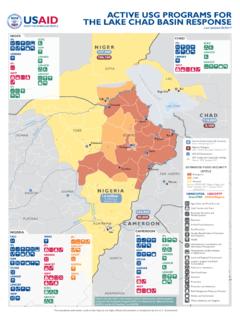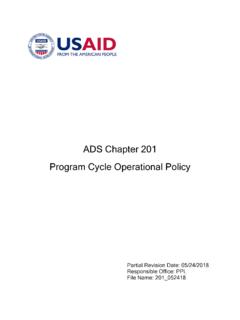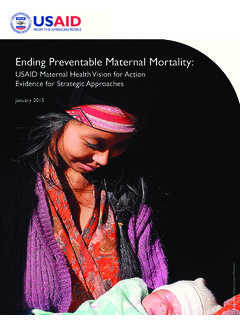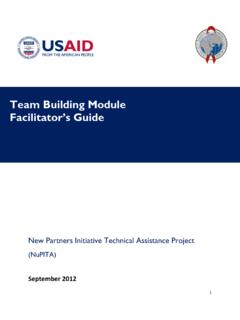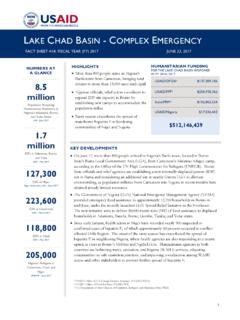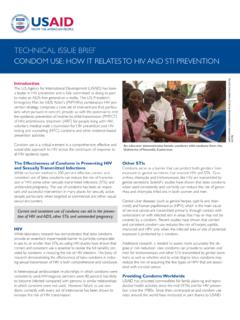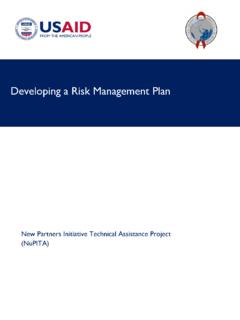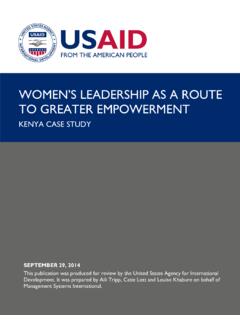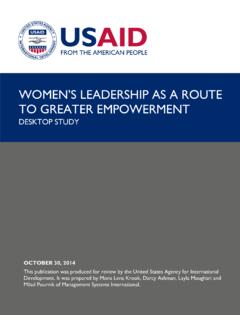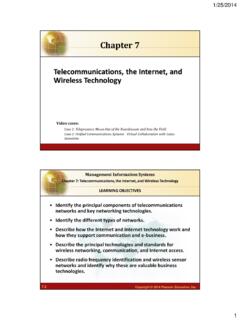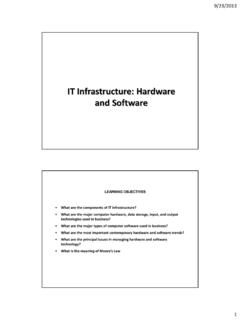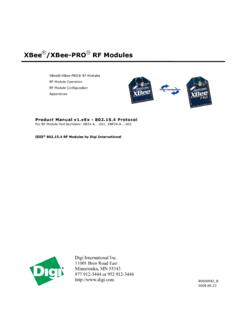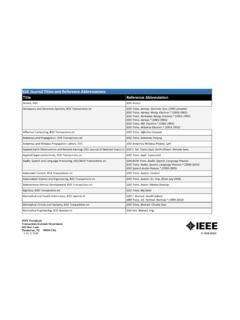Transcription of Wireless Standards and Guidelines
1 Wireless Standards and Guidelines A Mandatory Reference for ADS Chapter 545. Full Revision Date: 02/11/2019. Responsible Office: M/CIO/IA. File Name: 545mbg_021119. TABLE OF CONTENTS. 1. Introduction 3. 2. Purpose 3. 3. Audience 3. 4. Scope 3. Definitions 3. Individuals 4. Technologies, Networks, and Communications 4. Wireless Technology Locations 4. Classifications of Information 5. 5. Exceptions 5. 6. Wireless Spectrum Standard 5. Wireless Network Standards (Wi-Fi) 6. Access Agreements (Wi-Fi) 7. 7. Security and Privacy 7. Cybersecurity 7. Implementation of Wi-Fi 7. Access and Usage Controls for Wi-Fi 8.
2 Technology Controls for Other Wireless Technologies 9. Encryption 9. Continuous Monitoring 10. Installation of, Relocation of, or Changes to Wi-Fi 10. 8. National Security Information Usage and Restrictions 11. Classified Systems and Workspaces 12. Sensitive Compartmented Information Facilities (SCIF) 12. 9. List of Acronyms 13. 2. 1. Introduction Wireless networks, technologies, and communications must comply with the minimum specifications outlined in the provisions of federal policy, laws, and Standards . The National Institute for Standards and Technology (NIST) is responsible for developing information security Standards and Guidelines including minimum requirements for federal information systems.
3 For Wireless networks, technologies, and communications, the specific NIST Special Publications (SPs) that constitute the mandatory framework for implementation are SP 800-48, SP 800-97, and SP 800-153. NIST Guidelines are consistent with the requirements of the Office of Management and Budget (OMB) Circular A-130, Managing Information as a Strategic Resource. Federal Information Security governance is in United States Code (USC) (a) 44 USC. Chapter 35, Coordination of Federal Information Policy, (b) Public Law 107-347, E- Government Act of 2002, and (c) the Federal Information System Management Act of 2002 (FISMA).
4 2. Purpose The purpose of this document is to describe the Standards and provide Guidelines for Wireless networks, technologies, and communications. Wherever appropriate, it references other documents that either support a given statement or dictate a required action. 3. Audience The intended audience for this Standards and Guidelines document is the USAID. workforce, but primarily System Owners (SOs, Information System Security Officers (ISSOs)), IT designers, developers, operational personnel, and auditors ( , intra- office auditors, Agency auditors, or external auditors). 4. Scope Wireless communications are at the Open System Interconnect (OSI) model's Layer 1.
5 (L1); that is, the physical layer. The standard captured in this mandatory reference ( Standard ) focuses only on L1 with respect to Wireless networking and communications. Definitions 1. Portable Electronic Device (PED): is an electronic device having the capability to store, record, and/or transmit text, images/video, or audio data. For the purposes of this policy, Mobile Devices (MDs) are a subset of PED. An MD is defined as a 3. PED that: (i) has a small form factor such that it can easily be carried by a single individual; (ii) is designed to operate without a physical connection ( , wirelessly transmit or receive information); (iii) possesses local, non-removable data storage; and (iv) is powered-on for extended periods of time with a self- contained power source.
6 MDs may also have voice communication capabilities, on-board sensors that allow the device to capture information ( , photograph, video, record, or determine location), and/or built-in features to synchronize data with remote locations. Examples include smart phones, tablets, e-readers, and smart watches, or otherwise Wireless -enabled wearable technology devices. 2. Wireless technologies: are the systems of hardware and its software protocols that permit the transfer of information between separated points without physical connection. 3. Wireless Device: is hardware that receives and/or transmits Wireless frequencies of the electromagnetic (EM) spectrum that's used for communicative purposes.
7 Individuals This Standard applies to all members of the USAID workforce, including individuals in a direct or support capacity. For the purposes of this Standard, the term workforce applies to all individuals working for, or on behalf of, the Agency, regardless of hiring or contracting mechanism, who have physical and/or logical access to USAID facilities and information systems. This includes Direct-Hire employees, Personal Services Contractors, Fellows, Participating Agency Service Agreements, and contractor personnel. Note: Contractors are not normally subject to Agency policy and procedures as discussed in ADS However, contractor personnel are included here by virtue of the applicable clauses in the contract related to HSPD-12 and Information Security requirements.
8 Technologies, Networks, and Communications This Standard applies to all government or contractor-owned or operated Wireless technologies used for USAID business, and may apply to personally owned Wireless technologies when used for USAID business. Wireless Technologies are the systems of hardware and its software protocols that permit the transfer of information between separated points without physical connection. Some examples include (i) Wi-Fi, which follows the Institute of Electrical and Electronics Engineers' (IEEE) Standard; (ii). Bluetooth, which follows the IEEE standard; (iii) cellular such as 3G/4G/5G.
9 LTE; (iv) microwave; (v) satellite; and (vi) infrared. A Wireless Device (WD) is hardware that receives and/or transmits Wireless frequencies of the electromagnetic (EM). spectrum that's used for communicative purposes. Wireless Technology Locations 4. This Standard applies to USAID Wireless networks, technologies, and communications located within the continental United States (CONUS) and outside of the CONUS. (OCONUS), and locations in or near USAID facilities or workspaces where USAID. Wireless networks, technologies, and communications are accessible. For the purposes of this Standard, the term controlled space means USAID managed facilities in domestic and overseas posts.
10 For guidance on restricted space, please see ADS 565. and ADS 568. Classifications of Information This Standard applies only to unclassified information and devices. It does not apply to classified information or classified devices at any level. For classified Standards , see ADS 552, Cyber Security for National Security Information (NSI) Systems for guidance. In the event of a security incident involving classified information on Wireless networks or devices, users must immediately contact both the M/CIO Service Desk at (202) 712-1234 or and the Office of Security (SEC) as instructed in ADS 552 and ADS 568, National Security Information Program.
